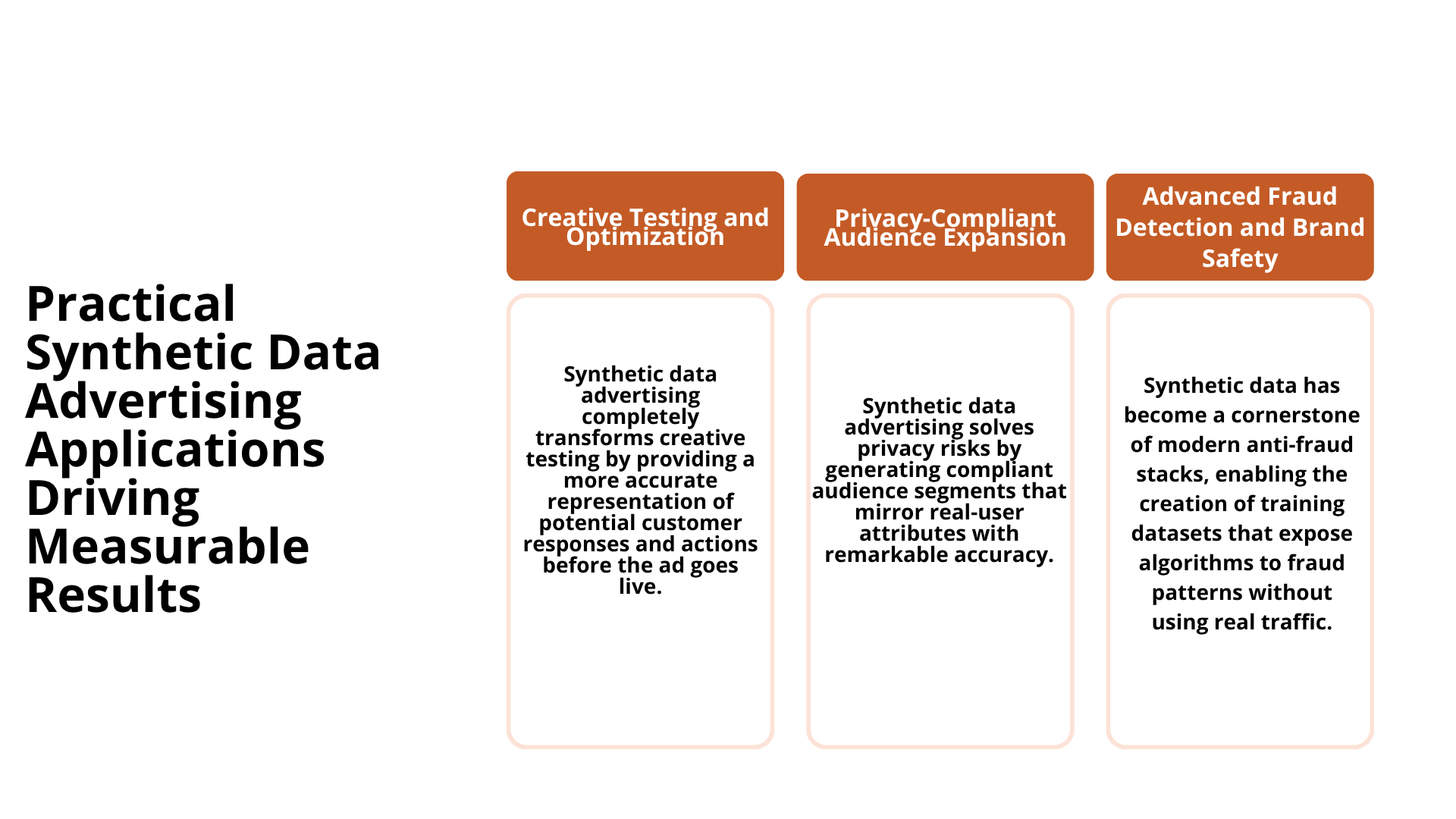How to Scale Campaigns Using Synthetic Data Advertising
The global synthetic data generation market is projected to explode from $218.4 million in 2023 to $1.79 billion by 2030, representing a staggering 35.3% compound annual growth rate. This growth signals how quickly brands and agencies are embracing synthetic data capabilities, including creative testing, segmentation, and privacy-safe analytics, in their advertising stacks.
For marketing leaders grappling with the deprecation of cookies, stricter privacy regulations, and the constant pressure to deliver measurable ROI, synthetic data advertising offers a game-changing solution. Instead of relying on increasingly limited real consumer data, savvy marketers are generating artificial datasets that mirror real-world patterns while eliminating privacy concerns and compliance headaches.
The results speak for themselves: companies implementing synthetic data strategies report 70% lower data acquisition costs, 40% faster campaign cycles, and significantly improved targeting accuracy—all while maintaining complete regulatory compliance.
Key Takeaways
- Synthetic data advertising delivers measurable cost savings and performance improvements, with companies reporting 70% lower data acquisition costs, 40% faster campaign cycles, and significantly improved targeting accuracy while maintaining complete regulatory compliance.
- Creative testing can be revolutionized through AI-generated synthetic respondents that produce concept-preference scores within five percentage points of real-panel results while cutting research time and cost by roughly 80%.
- Privacy-compliant audience expansion becomes possible without third-party data as synthetic data advertising generates GDPR-compliant audience segments that mirror real-user attributes within 10% accuracy, delivering double-digit lifts in return on ad spend.
- Advanced fraud detection capabilities save billions in ad spend, with synthetic data models achieving a 92% reduction in potential ad-fraud losses, equivalent to $10.8 billion saved in 2023 through improved invalid traffic detection.
- Early adoption provides a sustainable competitive advantage as brands reaching synthetic data maturity demonstrate 2.3x faster campaign iteration and 45% lower compliance costs.
TABLE OF CONTENTS:
Understanding Synthetic Data Advertising: Beyond Traditional Anonymization
Synthetic data advertising refers to the practice of using datasets generated by AI and machine learning models. This data replicates the statistical properties and behavioral patterns of real consumer data without containing any actual personal identifiers. Unlike traditional anonymization techniques that simply mask identifiable elements, synthetic data constructs entirely new datasets from scratch. This ensures advertisers can use real data without privacy risks.
Think of it as creating a parallel universe of consumers who behave exactly like your real audience but don’t actually exist. These synthetic personas replicate the same purchasing behaviors, demographic distributions, and engagement patterns as real users, allowing for precise targeting and personalization.
“Synthetic data resolves the fundamental tension between delivering personalized experiences and respecting consumer privacy boundaries. It’s not just about compliance. It’s about unlocking campaign performance that was previously impossible to achieve.” – Marketing Technology Research, 2025
The technology utilizes advanced methods, including generative adversarial networks (GANs), variational autoencoders, and agent-based modeling, to create these datasets. Gartner projects that by 2024, 60% of the data used in AI will be synthetic. Because AI models drive modern ad buying, targeting, and creative optimization, this projection implies that synthetic data will soon underpin the majority of advertising-related AI workflows.
Practical Applications Driving Measurable Results

Synthetic data improves ad targeting by replicating user preferences, behaviors, and demographics. But how can advertisers use synthetic data to drive results?
Creative Testing and Optimization
Before, traditional creative testing relied on expensive, slow-to-recruit real consumer panels, which limited sample size and delayed campaign decisions. Synthetic data advertising completely transforms this process by providing a more accurate representation of potential customer responses and actions before the ad goes live.
At the ESOMAR Congress 2024, Fairgen demonstrated the ability to run 7,000 parallel ad-creative tests using AI-generated synthetic respondents, benchmarked against Pew Research Center data. The results were remarkable: synthetic panels produced concept-preference and creative-performance scores that deviated by less than five percentage points from those of real panels, while reducing research time and cost by approximately 80%.
77% of organizations that have adopted generative AI use it for creative development tasks, rising to 84% among high-performing marketing organizations. This signals that synthetic data-driven creative processes are becoming a competitive differentiator, especially for high-performing brands.
Privacy-Compliant Audience Expansion
GDPR and similar regulations have severely limited traditional audience data collection, forcing marketers to work with increasingly smaller, less effective datasets. Synthetic data advertising solves this by generating compliant audience segments that mirror real-user attributes with remarkable accuracy.
Spike Digital generated GDPR-compliant synthetic audience segments that mirrored real-user attributes within approximately 10% accuracy, then activated these segments for look-alike targeting across paid media channels. The campaigns using synthetic audiences delivered a double-digit increase in return on ad spend and reduced third-party data licensing costs, while maintaining all targeting fully compliant with privacy regulations.
Advanced Fraud Detection and Brand Safety
Ad fraud costs the industry billions annually, with sophisticated fraud rings constantly evolving their tactics. Synthetic data has become a cornerstone of modern anti-fraud stacks, enabling the creation of training datasets that expose algorithms to fraud patterns without using real traffic. The process involves simulating synthetic data that replicates fraudulent advertising activities, such as traffic from bots or fake clicks. AI can use these simulations to train its systems to detect and prevent ad fraud. As a result, the system will be able to pinpoint any anomalies in performance metrics before they affect the campaign.
MarTech reports a 92% reduction in potential ad-fraud losses—equivalent to $10.8 billion saved in 2023. The industry-wide deployment of synthetic-data-driven machine-learning models that simulate real and fraudulent traffic patterns significantly enhances the detection and blocking of invalid traffic (IVT) in real-time.
Building Your Synthetic Data Advertising Framework
Successful synthetic data advertising implementation follows a strategic, phased approach that balances innovation with risk management:
| Phase | Focus Area | Key Capabilities | Expected ROI Impact |
|---|---|---|---|
| 1 | Regulatory Compliance | Privacy-safe audience expansion, consent-free lookalike modeling | Compliance cost reduction by 60-70% |
| 2 | Creative Optimization | Synthetic A/B testing environments, rapid creative iteration | 40% faster campaign development cycles |
| 3 | Predictive Analytics | Market scenario modeling, competitive response simulation | 28% improvement in forecast accuracy |
| 4 | Autonomous Systems | Self-optimizing campaigns, closed-loop adaptation | 2.3x faster optimization cycles |
Technical Implementation Considerations
Four primary techniques dominate synthetic data generation in advertising contexts:
- Distribution-based sampling: Draws from known statistical distributions to create representative datasets for A/B testing platforms.
- Agent-based modeling: Simulates interactions between consumer “agents” to predict emergent behaviors in new markets.
- Generative adversarial networks (GANs): Produce synthetic consumer profiles through competing generator-discriminator networks.
- Differentially private synthesis: Adds mathematical noise to real datasets before generating privacy-compliant derivatives.
Quality validation requires rigorous testing against three criteria: statistical similarity (matching distributions of real data), predictive parity (producing equivalent model accuracy), and privacy preservation (preventing re-identification). Leading platforms achieve a correlation of greater than 90% in engagement metrics between synthetic and real campaign predictions.
Real-World Success Stories and Measurable Outcomes
The proof of synthetic data advertising’s effectiveness lies in concrete business results across diverse industries:
- Financial services innovation: JPMorgan Chase integrated Persado’s generative AI platform to create synthetic ad copy variants, systematically testing emotional triggers and value propositions. After training language models on historical campaign data without accessing customer personally identifiable information (PII), the system generated compliant alternatives that increased click-through rates by 450% while reducing compliance review cycles by 70%.
- Retail brand campaigns: Nike combined synthetic consumer behavior data with generative creative tools to produce their “Never Done Evolving” campaign. Synthetic match simulations between Serena Williams’ 1999 and 2017 Grand Slam performances facilitated emotionally resonant narrative development prior to filming. Post-launch analysis attributed 23% higher engagement to the synthetic testing phase, which identified optimal emotional appeal combinations.
- Streaming media personalization: Netflix developed synthetic engagement datasets that predict thumbnail preference for their 200+ million subscribers. After generating artificial viewing histories mirroring real behavior patterns, the platform trains convolutional neural networks to select imagery that maximizes session starts. This synthetic approach increased content discovery by 18% while eliminating privacy reviews previously required for real viewing data.
These case studies demonstrate that synthetic data advertising is driving tangible business outcomes across multiple verticals and use cases. The key lies in strategic implementation that balances automation with human insight.
Overcoming Implementation Challenges
While synthetic data advertising offers tremendous potential, successful implementation requires addressing several key challenges:
- Data quality and validation: The primary risk involves ensuring statistical fidelity. When generative models oversimplify complex behaviors, campaigns may generate misleading insights. Mitigation requires robust validation frameworks that compare synthetic-to-real divergence across more than 200 metrics, as well as “reality check” periods where synthetic-driven campaigns are run in limited markets before full deployment.
- Ethical and brand safety considerations: If training datasets underrepresent minority groups, synthetic outputs may perpetuate bias in ad targeting. Solutions include algorithmic audits that measure demographic parity in synthetic audience generation, as well as balancing synthetic testing with ethnographic reality checks to maintain cultural authenticity.
- Integration and skills gaps: Legacy marketing systems often lack APIs for ingesting synthetic data, creating implementation bottlenecks. Forward-thinking agencies address this challenge through middleware platforms and dedicated synthetic data labs, which build internal competencies.
The most successful implementations integrate synthetic simulations with human oversight, using algorithmic outputs to inform rather than dictate creative decisions. Advanced AI systems can enhance this process by providing intelligent recommendations based on synthetic data insights.
Strategic Outlook: The Future of Privacy-Safe Advertising
By 2030, synthetic data is expected to underpin the majority of analytics and AI projects, according to industry projections. Privacy regulations will simultaneously evolve to certify synthetic data generators, much like the EU’s GDPR certification for cloud services.
Near-term innovations focus on synthetic data that models behavioral evolution across customer lifecycles. Adobe’s prototype “Journey Simulator” generates longitudinal synthetic consumers whose preferences adapt to market stimuli, enabling predictive lifecycle marketing. Multimodal synthetic data combining visual, textual, and transactional elements will enable holistic campaign testing.
The most transformative development involves blockchain-validated synthetic data, where decentralized verification networks will certify data provenance and usage rights. This becomes critical for royalty calculations in synthetic influencer campaigns, ensuring transparency in personalized advertising at scale.
Brands that reach synthetic data maturity by 2026 will gain a sustainable competitive advantage. Early adopters demonstrate 2.3 times faster campaign iteration and 45% lower compliance costs compared to their peers. The technology positions itself as foundational to future-proof marketing strategies.
Maximizing Your Synthetic Data Advertising ROI
Synthetic data advertising is already becoming the norm and will replace traditional ad datasets in the near future. AI and machine learning generate this type of data and act to replicate real customer information and behaviors without using real datasets. Not only does synthetic data result in cost savings and increased efficiency, but it is also more compliant with privacy laws. This technology is what industry experts call “a strategic necessity in the privacy-first era”—one that empowers marketers to innovate fearlessly while honoring consumer trust.
In an era where privacy and personalization must coexist, synthetic data advertising provides the bridge between these seemingly opposing forces. Advertisers can utilize synthetic data to enhance testing and execution without compromising human intuition, empathy, and cultural awareness. Synthetic data offers a privacy-safe foundation for testing hypotheses and optimizing campaigns at unprecedented scale and speed. Additionally, advertisers can simulate fraudulent activity to better train their systems to protect against malicious attacks.
Ready to explore how synthetic data can transform your advertising performance? Work with the leading paid advertising agency that combines cutting-edge technology with proven growth strategies to deliver measurable results for ambitious brands.
Ready to cut your data costs by 70% while speeding up your campaigns?
Frequently Asked Questions
-
What is synthetic data advertising and how does it work?
Synthetic data advertising uses generated datasets that replicate the behavioral patterns of real consumer data without containing actual personal identifiers. Unlike traditional anonymization, which masks identifiable elements, synthetic data constructs entirely new datasets from scratch using advanced methods such as generative adversarial networks (GANs) and agent-based modeling.
-
What are the main benefits of using synthetic data in advertising campaigns?
Companies implementing synthetic data strategies report 70% lower data acquisition costs, 40% faster campaign cycles, and significantly improved targeting accuracy while maintaining complete regulatory compliance. Additionally, it eliminates privacy concerns and compliance headaches associated with traditional consumer data usage. Synthetic data is overall more diverse and scalable and comes with fewer biases than conventional data collection methods.
-
How can synthetic data improve creative testing and optimization?
Synthetic data enables the running of thousands of parallel ad-creative tests using AI-generated respondents, which produce concept-preference scores within five percentage points of the results from real panels. This approach reduces research time and cost by approximately 80% compared to traditional consumer panels, while enabling rapid iteration of creative ideas.
-
What are the key phases for implementing a synthetic data advertising framework?
Implementation follows four phases: regulatory compliance (privacy-safe audience expansion), creative optimization (synthetic A/B testing), predictive analytics (market scenario modeling), and autonomous systems (self-optimizing campaigns). Each phase builds capabilities while delivering measurable ROI improvements, from a 60-70% reduction in compliance costs to 2.3 times faster optimization cycles.
-
What technical methods are used to generate synthetic advertising data?
Four primary techniques dominate: distribution-based sampling for A/B testing, agent-based modeling for simulating consumer behavior, generative adversarial networks (GANs) for generating synthetic consumer profiles, and differentially private synthesis for creating privacy-compliant derivatives. Leading platforms achieve a correlation of greater than 90% in engagement metrics between synthetic and real campaign predictions.
-
What challenges should I expect when implementing synthetic data advertising?
Key challenges include ensuring data quality and statistical fidelity, addressing potential bias in synthetic outputs, and overcoming integration barriers with legacy marketing systems. Success requires robust validation frameworks, algorithmic audits for demographic parity, and a balance of synthetic insights with human oversight to maintain cultural authenticity.
-
How do I measure ROI from synthetic data advertising initiatives?
Track three core metrics: compliance cost reduction (60-70% typical savings), campaign development speed (40% faster cycles), and targeting accuracy improvements (double-digit ROAS lifts common). Validate synthetic predictions against real-world data regularly and measure the improvements in fraud detection, which can save billions in ad spend through more effective invalid traffic detection.




